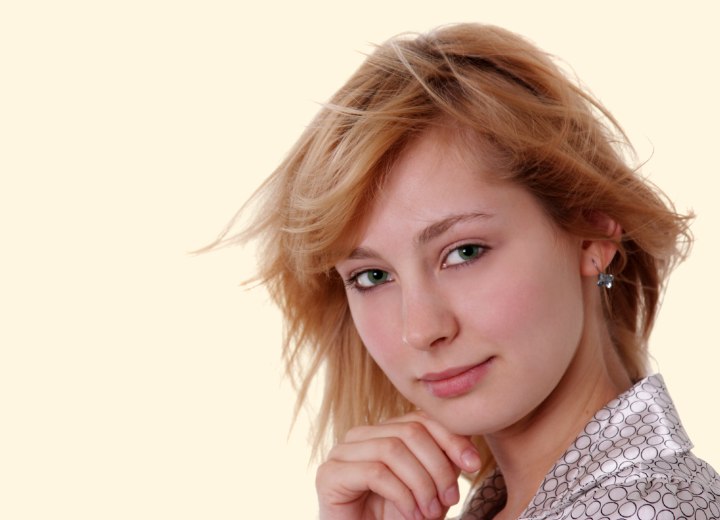High-Lift Color

I'm wondering if high-lift color would be more effective than the 8AA, or what toners might work better. I'm not very familiar with toners and would appreciate specific brand recommendations. When I visit the beauty supply store, there's rarely a knowledgeable cosmetologist available to guide me. Additionally, her hair becomes noticeably brassy and dull after about two weeks. What can I do to address this? Also, would processing her hair under a dryer create a blonder result? Thank you for your expertise.
A: This is one of the most common challenges new colorists face, and it's completely understandable that you're looking for a more efficient solution. Your client's situation actually represents a classic color correction scenario that requires understanding the underlying color theory.
Let's analyze what's happening with the 8AA. Both Matrix and ISO use this code to indicate Light Soft Ash Blonde. While ash tones (which contain blue-green pigments) are generally appropriate for neutralizing warmth, a standard level 8 color simply doesn't contain enough lifting power to get your client's natural level 4-5 hair to a true level 8. Instead, you're likely achieving only a level 6-7 lift, where orange pigment still predominates, and the ash tone isn't sufficient to neutralize it completely.
For your specific situation, I recommend a two-step approach rather than trying to lift and tone simultaneously:
Step 1, Lightening: A high-lift color would be more appropriate than regular permanent color. Products like Redken High-Lift Naturals or Wella Blondor Plus can lift natural hair up to 4-5 levels when used with 40-volume developer. Apply to new growth only, and process according to the manufacturer's instructions (typically 35-45 minutes). You could also consider using an off-scalp lightener (bleach) with 20 or 30-volume developer for even more lifting power.
Step 2, Toning: Once you've achieved a sufficiently light base (ideally pale yellow, or at least gold), toning becomes crucial. For orange-toned hair, you'll need a toner with blue-violet base pigments. Here are some specific recommendations:
• Wella Color Charm T14 (Pale Ash Blonde) or T18 (Lightest Ash Blonde)
• Redken Shades EQ 9V or 9P
• Joico Lumishine Demi-Permanent Liquid 10V or 10SB
• Schwarzkopf IGORA ROYAL Absolutes Silverwhite Silver Toner
Use these with a low-volume developer (6-10 volume) to deposit tone without further lifting. Process for 15-20 minutes, checking frequently.
Regarding your question about using heat: Yes, placing your client under a dryer during the lightening process can indeed accelerate lifting and potentially achieve a blonder result. The heat opens the cuticle further and speeds up chemical reactions. However, this also increases the risk of damage and scalp sensitivity, so start with 5-10 minutes of heat, then let the color process at room temperature for the remaining time.
For the brassiness that develops after two weeks, implement a comprehensive maintenance strategy:
1. Home Care Products: Recommend a professional-grade purple shampoo and conditioner system like Joico Color Balance Purple, Redken Color Extend Blondage, or Amika Bust Your Brass. Instruct your client to use these products 1-2 times weekly.
2. Leave-In Protection: A blue/purple leave-in product like Matrix Total Results Brass Off Leave-In or Olaplex No.6 with a drop of purple shampoo mixed in can provide ongoing toning.
3. Water Quality Considerations: Hard water with mineral content can contribute significantly to brassiness. Suggest a shower filter or chelating shampoo (like Malibu C Hard Water Wellness) used bi-weekly.
4. Heat Protection: Ensure your client uses heat protectant products, as heat styling accelerates color fading and reveals underlying warm pigments.
Most importantly, manage expectations. Moving from a level 4-5 to a beautiful, cool blonde requires ongoing maintenance both in the salon and at home. Consider scheduling 4-5 week appointments rather than stretching to 6-8 weeks, as this will make each color service more manageable and yield more consistent results.
Mastering blonde transformations takes time and practice. Each client's hair responds differently based on porosity, previous chemical services, and natural pigmentation. Keep detailed records of formulas and processing times to refine your approach with each visit.
©Hairfinder.com
See also:
Hair coloring
Hair coloring problems in a salon setting